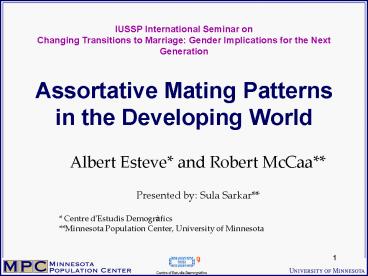1 PowerPoint PPT Presentation
Title: 1
1
Assortative Mating Patterns in the Developing
World
IUSSP International Seminar on Changing
Transitions to Marriage Gender Implications for
the Next Generation
- Albert Esteve and Robert McCaa
- Presented by Sula Sarkar
- Centre dEstudis Demogràfics
- Minnesota Population Center, University of
Minnesota
2
Data source IPUMS
- Preserve census microdata and documentation for
all the countries in the world - Integrate microdata and metadata
- Disseminate--without cost--extracts of samples to
bona-fide researchers worldwide, regardless of
country of birth, citizenship or residence. - Sustained, major funding since 1999 by
- National Science Foundation (USA)
- National Institutes of Health (USA)
- https//international.ipums.org/international/
3
IPUMS-International census microdata, Sept.
2008dark green already integrated (35
countries, 111 censuses, 263 millon person
records)green to be integrated (40 countries,
104 censuses, 150 mill.)
Mollweide projection
www.ipums.org
4
Introduction
- Basic concepts
- Homogamy versus hetrogamy
- Hypergamy versus hypogamy
- Unions between people with similar
characteristics make up the predominant pattern - Impact of education on assortative mating
patterns
5
Objectives
- Study effect of changes in age at marriage and
increasing schooling on the prevalence and
conditions of unions in various contexts of the
developing world - Assess levels of educational homogamy in eight
developing countries - How do gender differences in educational
attainment translate into gender differences in
heterogamy
6
Countries included in this study
7
Samples included in study
8
Hypothesis
-- Higher levels of educational homogamy
correspond to groups located at the extremes of
the hierarchy. -- Positive relationship between
gender inequalities in access to education and
levels of educational hypergamy.
9
Methodology
-- Sampling methods stratified
sampling stratified cluster sampling (2005
Colombia, 2000 Mexico,
all India samples) -- Variables of
interest ever married and never
married educational homogamy -- Statistical
Methods Loglinear models Logistic regression
10
Percentage of never married (nor in union) by sex
and country (ages 30 - 34), last census available
NOTE Brazil 2000 China 1990 Colombia 2005
Iraq 1997 Kenya 1999 Mexico 2000 Philippines
2000 South Africa 2001 India 2005
11
Estimated log odds ratios from a logistic
regression of the highest educated (univ. degree)
and never married (age 25-34)
NOTE Brazil 2000 China 1990 Colombia 2005
Iraq 1997 Kenya 1999 Mexico 2000 Philippines
2000 South Africa 2001 India 2005
12
Distribution of women (age 15 - 34) in union by
educational attainment and country
NOTE Brazil 2000 China 1990 Colombia 2005
Iraq 1997 Kenya 1999 Mexico 2000 Philippines
2000 South Africa 2001 India 2005
13
Distribution of men (age 15 - 34) in union by
educational attainment and country
NOTE Brazil 2000 China 1990 Colombia 2005
Iraq 1997 Kenya 1999 Mexico 2000 Philippines
2000 South Africa 2001 India 2005
14
Distribution of women (age 30 - 34) in union by
educational homogamy - heterogamy and country
15
Estimated log odds ratios from a loglinear
regression of overall educational homogamy and
hypergamy (women age 15 - 34)
Homogamy
Hypergamy
16
Estimated log odds ratios from a loglinear
regression of educational homogamy by educational
attainment, Women ages 15 - 34
Primary Completed
Less than Primary
17
Estimated log odds ratios from a loglinear
regression of educational homogamy by educational
attainment, Women ages 15 - 34
Secondary Completed
University Completed
18
Concluding remarks
- Availability of international census microdata
offers an unprecedented opportunity to carry out
cross-national research on marital homogamy and
other topics - Significant changes are underway as union
formation, particularly for females, is postponed
to the mid-twenties and beyond. The proportions
of never-marrying (or not in union) increase - Educational attainment is an important factor in
all these developments - While homogamy rules everywhere, there is a
surprising shift away from the conventional
heterogamous pattern - It is the female who brings greater educational
attainment to the union than the male - There are important differences between and
within broad cultural regions
19
Thank you!! Albert Esteve aesteve_at_ced.uab.esRo
bert McCaa rmccaa_at_umn.eduSula Sarkar
sula_at_socsci.umn.edu

